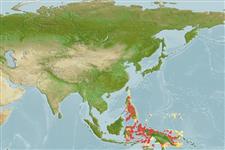Classification / Names
Common names from other countries
Main reference
Size / Weight / Age
Max length : 30.0 cm TL male/unsexed; (Ref. 5222)
Environment
Marine; reef-associated; depth range 0 - 30 m (Ref. 9710)
Climate / Range
Tropical, preferred ?; 23°N - 11°S, 120°E - 154°E (Ref. 5222)
Distribution
Western Pacific: Vietnam, Indonesia, Philippines, Taiwan, Solomon Islands (Ref. 4787) and New Britain.
Countries | FAO areas | Ecosystems | Occurrences | Introductions
Short description
Dorsal
spines
(total): 11;
Dorsal
soft rays
(total): 16-17;
Anal
spines: 3;
Anal
soft rays: 8. Characterized by grey brown color with scattered reddish brown to black spots; narrow pale margins on dark grey fins; body scales ctenoid, except cycloid scales dorsally and ventrally; body with auxiliary scales; greatest depth of body 2.8-3.2 in SL; rounded caudal fin; pelvic fins, 1.9-2.3 in head length (Ref. 90102); head length 2.3-2.6 times in SL; interorbital area flat to slightly convex, almost straight dorsal head profile; rounded preopercle, finely serrate, ventral serrae slightly enlarged; straight upper edge of operculum; maxilla reaches past rear edge of eye; 2 or 3 rows of teeth on midlateral part of lower jaw (Ref. 089707).
IUCN Red List Status (Ref. 115185)
Threat to humans
Harmless
Human uses
Fisheries: of no interest
More information
ReferencesAquacultureAquaculture profileStrainsGeneticsAllele frequenciesHeritabilityDiseasesProcessingMass conversion
Tools
Special reports
Download XML
Internet sources
Estimates of some properties based on models
Phylogenetic diversity index
PD50 = 0.5000 many relatives (e.g. carps) 0.5 - 2.0 few relatives (e.g. lungfishes)
Trophic Level
3.7 ±0.6 se; Based on size and trophs of closest relatives
Resilience
Medium, minimum population doubling time 1.4 - 4.4 years (Preliminary K or Fecundity.)
Vulnerability
Low to moderate vulnerability (32 of 100)
Price category
